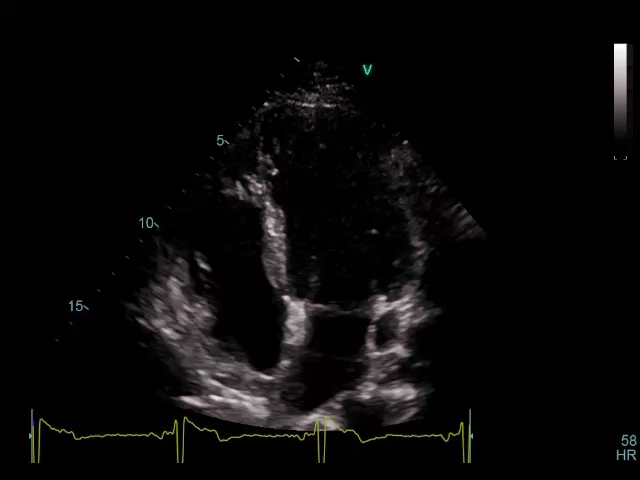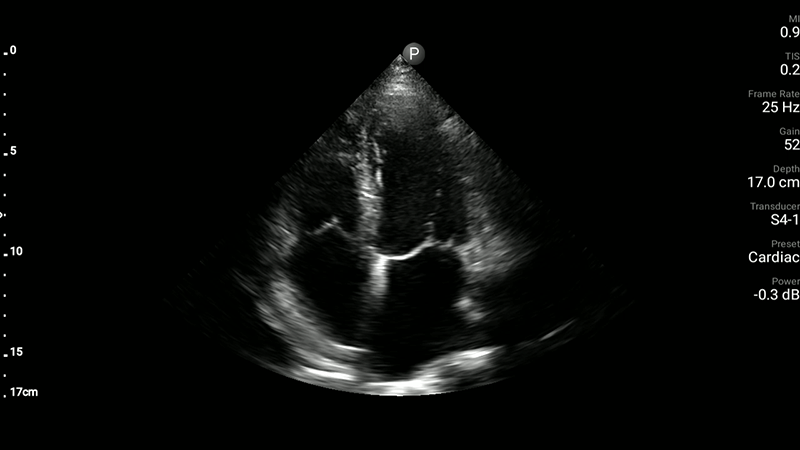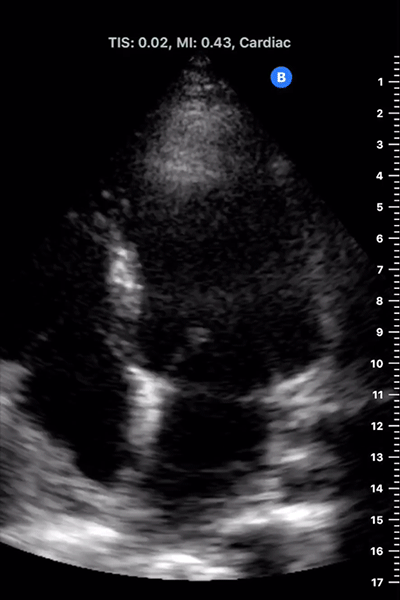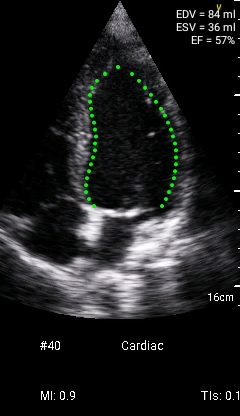The Latest in Cardiovascular Hand-Held Point-of-Care Ultrasound: The Power of Echocardiography Anytime, Anywhere
If you've been thinking of purchasing a hand-held ultrasound device for targeted assessment of cardiovascular conditions or for providing efficient and cost-effective access to focused noninvasive cardiovascular imaging, now may be a good time to consider the available options.
Recently, the iOS-compatible Butterfly iQ (Butterfly; Guilford, CT) pocket-sized transducer became available for purchase, starting under $2,000. To use Butterfly iQ, each user must also subscribe to a cloud Butterfly image storage service that costs an additional $420 per year. The device uses a silicon chip array, replacing the piezo-electric crystal, and uses sensors to emulate any type of transducer (linear, curved, or phased array.) This device is app based, plugs into an iPhone or iPad, and uses HIPAA (Health Insurance Portability and Accountability Act of 1996) compliant cloud technology for storage and retrieval of images. Butterfly iQ uses an augmented reality tool to provide guidance to novice sonographers on how to scan. Teleguidance is also available, offering advice on use of the device remotely. Like Butterfly iQ, Lumify (Koninklijke Philips N.V.; Amsterdam, Netherlands), which has now been available for a few years, also allows live streaming of images as they are being performed to any smart phone, tablet, or computer.
At Brigham and Women's Hospital, we recently tested Butterfly iQ, and our cardiovascular fellows have begun comparing it with other established hand-held devices including Lumify and Vscan (GE Healthcare; Chicago, IL) (Videos 1-4). At first glance, the $2,000 up-front cost of Butterfly iQ is less expensive than other point-of-care ultrasound devices currently on the market. However, the $420 annual fee per user adds to this cost. The starting price of Lumify has recently been reduced to $6,000 and includes all updates over 5 years. Lumify also offers a medical school/global health discounted price and provides leasing options ranging from $140 to $199 per month. Lumify plugs into an Android phone or tablet but does not currently work with the iPhone or iPad (Philips plans to have Lumify plug into all iOS devices by the end of 2019). Its detachable cable will be capable of being replaced with a lightning-style cable. Those who have already purchased Lumify within the last 5 years can upgrade to iOS/lightning cable without additional cost. GE's Vscan family of products has been available since 2010, and the latest hand-held point-of-care ultrasound device is its own dedicated unit that does not plug into a smart phone or tablet but is app based and currently runs on Android OS. It has both a dual-phased array and linear probe and can perform cardiac, general, and vascular-focused ultrasound studies. The cost of this device is $4,995 for the dual probe and $2,995 for the sector probe only.
Video 1
Video 2
Video 3
Video 4
On first inspection, the Butterfly iQ probe is small enough to fit in your white coat pocket, although it is larger and heavier than traditional cardiac ultrasound transducers because the battery that powers the device is built in. Lumify looks and feels more like a traditional cardiac transducer. The Vscan dual transducer has the linear probe on one end and the phased array on the other. Butterfly iQ requires charging both the transducer and the iPhone or iPad to keep it running. Both the Lumify and Vscan probes do not have separate batteries that need to be charged, requiring only the iOS or Android device to be charged. All three point-of-care ultrasound devices have harmonic imaging built in as well as automated image optimization capabilities. Both Lumify and Vscan offer DICOM output to your facility's picture archiving and communication system server or to a local network and can be used by multiple users. Butterfly iQ requires each user to have a subscription to the Butterfly Cloud service. All data in transit to the Butterfly cloud is encrypted. The company's logic for having the cloud service is to promote machine learning and artificial intelligence by storing de-identified data and selling it.
Battery life of Butterfly iQ, Lumify, and Vscan allows for approximately 120 minutes of continuous two-dimensional, m-mode, and color Doppler scanning. All are capable of linear measurements. None can perform spectral Doppler, which is a major limitation because spectral Doppler is the cornerstone to diagnosing and quantifying valvular pathology and diastolic dysfunction. Vscan recently introduced an automated ejection fraction app that can be purchased for an additional $475, which allows for machine-generated calculations of left ventricular volume and ejection fraction from the apical four-chamber view. Lumify images have recently been tested with off-line software and reportedly are capable of two-dimensional strain measurements. All are capable of focused, question-specific exams that may be life saving in the acute situation, and point-of-care ultrasound scans on the wards may allow for more efficient workflow in the inpatient echocardiography laboratory, possibly by preventing unnecessary, repetitive follow-up studies. Most importantly, these hand-held devices may allow more timely access to imaging for patients who cannot easily travel, as well as the estimated 4.7 billion people around the world who have no access to medical imaging.1
Hand-held cardiac ultrasound is relatively inexpensive, lightweight, and portable; compares favorably to the physical exam; and has great promise for more widespread dissemination of noninvasive cardiovascular imaging. However, none of these devices have the diagnostic power of high-end ultrasound systems, which have significantly higher frame rates and far more sophisticated quantitative technologies, including three-dimensional imaging.2 Training in the use of hand-held cardiac ultrasound devices has begun to be implemented in medical schools, including Harvard, and medical students perceive this training as valuable.3-5 Curriculums for training in point-of-care ultrasound by major cardiovascular societies are highly anticipated. Cardiologists who have already achieved level 2 or level 3 training can readily adapt to these hand-held devices.6
Although hand-held cardiac ultrasound devices offer the promise of improved and cost-effective access to medical imaging, appropriate use of this technology is critical in preventing a cost burden from overuse. Detailed reimbursement guides are available from each of the hand-held device vendors. In general, private insurance and Medicare payment policies vary by payer and plan, with some payers requiring specific credentials and/or restricting the imaging procedures covered to specific specialties. If the device is used for teaching or as a replacement for the stethoscope, images may not be stored, documentation of use may be provided in the physical exam section of a progress note, and billing would be considered an extension of evaluation and management services.7,8 As more images are transferred, stored, and billed for, the need for regulation will likely increase, including mechanisms for assuring patient confidentiality, access and maintenance of secure images with official reports for a minimum number of years, validation of operator training, bioengineering certification of devices, and accreditation of facilities.
References
- World Health Organization. Baseline country survey on medical devices (World Health Organization website). 2010. Available at: https://www.who.int/medical_devices/publications/baseline_country_survey_med-dev/en/. Accessed June 7, 2019.
- Pathan F, Narula J, Marwick TH. Handheld Echocardiography. In Solomon SD, Wu JC, Gillam LD, eds. Essential Echocardiography. New York: Elsevier, Inc; 2019:447-455.
- Johri AM, Durbin J, Newbigging J, et al. Cardiac Point-of-Care Ultrasound: State-of-the-Art in Medical School Education. J Am Soc Echocardiogr 2018;31:749-60.
- Rempell JS, Saldana F, DiSalvo D, et al. Pilot Point-of-Care Ultrasound Curriculum at Harvard Medical School: Early Experience. West J Emerg Med 2016;17:734-40.
- Almufleh A, Di Santo P, Marbach JA. Training Cardiology Fellows in Focused Cardiac Ultrasound. J Am Coll Cardiol 2019;73:1097-100.
- Spencer KT, Kimura BJ, Korcarz CE, Pellikka PA, Rahko PS, Siegel RJ. Focused cardiac ultrasound: recommendations from the American Society of Echocardiography. J Am Soc Echocardiogr 2013;26:567-81.
- Lumify Reimbursement Guide (Philips website). 2016. Available at: http://incenter.medical.philips.com/doclib/enc/13148783/Lumify_Reimbursement_Guide.pdf. Accessed June 7, 2019.
- Medicare Claims Processing Manual (Centers for Medicare & Medicaid Services website). 2019. Available at: https://www.cms.gov/Regulations-and-Guidance/Guidance/Manuals/Internet-Only-Manuals-IOMs-Items/CMS018912.html. Accessed June 7, 2019.
Clinical Topics: Noninvasive Imaging, Computed Tomography, Echocardiography/Ultrasound, Nuclear Imaging
Keywords: Point-of-Care Systems, Imaging, Three-Dimensional, Follow-Up Studies, Heart Ventricles, Global Health, Stroke Volume, Inpatients, Ultrasonography, Echocardiography, Radiology Information Systems, Artificial Intelligence, Medicare, Software, Documentation, Bioengineering, Tomography, X-Ray Computed, Stethoscopes, Methyltestosterone, Health Insurance Portability and Accountability Act, Diagnostic Imaging, Cardiac Imaging Techniques
< Back to Listings




